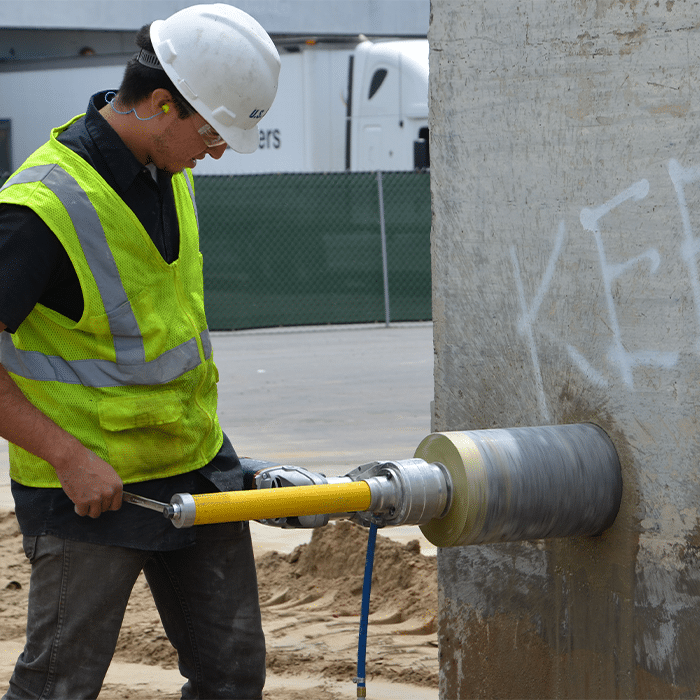As the use of concrete expands in both building construction for the residential and business world, as well as for municipal structure, the use of concrete drills rises as well. Concrete drills are fantastic tools, but, as with any power tool, there are certain precautions you should take to ensure your safety and to come away from the job or project with all of your digits intact.
Below are four key recommended safety measures to protect you when preparing to use a concrete drill.
Know Your Surroundings
The first piece of the concrete drill safety puzzle is to make sure you know what you are getting into. Before starting a job, fully inspect the worksite. Ensuring that the area is free of debris and is not slippery will help you keep your balanced with feet flat on the ground for a solid stance. Make sure the area is properly lit so that you can see what it is you are drilling into and to keep an eye on the debris released during the drilling process. When setting up your worksite, take extra care to confirm the area has proper ventilation. Gas powered drills release carbon monoxide which can be lethal.
It is also important to properly inspect your concrete drill prior to use. Check that the machine guards are in working order and that all parts are properly mounted and aligned. If a part is not functioning optimally, make the necessary repairs prior to use. Failure to inspect your tool’s grip, mounts and other parts can lead to a tool’s malfunction which can in turn lead to injury on the part of the user.
Set Yourself Up for Success
The second key safety measure for concrete drill safety is the use of protective gear. Besides OSHA regulations requiring the use of certain protective gear, it is always a good idea to take simple precautions to protect yourself. Concrete drills are power tools, and as with other power tools, concrete drills require certain safety gear to ensure you emerge from the job in one piece. First and foremost, are safety glasses. Protective eye wear should protect not just the front of the eye, but also the sides. Fast moving debris is a risk when drilling, which could become lodged in your eyes without the proper eye wear. A face covering is also vital to protect your nose, mouth, throat and lungs from concrete dust.
Other simple precautions will help reduce your risk of injury too. Pulling back long hair to ensure it does not get caught in the motor and avoiding loose fitting clothing that also could risk getting caught in the motor are important to remember. Gloves and non-skid foot wear will also protect your hands and feet from injury.
Go In with a Game Plan
Third, as with most jobs, it makes the most sense to attack the task with a game plan. Knowing the premises, ensuring you have the proper number of workers on site to complete the task at hand, and understanding what the expected outcome of the work is will put you on the path to success. Having a plan and executing that plan precisely will help you perform your concrete drilling task with the least amount of danger, in the optimal amount of time, with the best possible outcome.
When preparing your game plan, make sure to know the size of the drill and drill bit that the task requires. Be aware of the required depth of the cut. This will aid you in deciding whether or not a drill stand is necessary for the job. Using tools that are too small for the job may cause overheating of motors which can then cause injury. Using incorrect drill bits for the depth of the cut or surface being drilled can cause bits to bounce out of holes, which is also a safety issue. Being prepared with all of the right accessories to complete your cutting job is a key component to pulling off a safe and successful plan.
Watch for Waste
Finally, the besides potentially losing a digit to a dropped drill or passing out from carbon monoxide poisoning, concrete dust is the most dangerous hazard faced in concrete drilling. Working cleanly and efficiently will help reduce the amount of concrete dust to which you are exposed. The dust particles that are released into the air are respirable crystalline silica. These particles are much finer than grains of sand and may be inhaled on the job without the right protective gear. It takes some time for the light silica particles to settle, so they may remain a hazard even after the job is complete. Wet drilling, dust shrouds and vacuums are efficient ways to handle the large amount of concrete dust released during the drilling process.
Knowing and understanding the risks of concrete drills will help reduce the hazards you face while using it. Keeping in mind the four above concrete drill safety elements when preparing to use a concrete drill will ensure a job well done by an uninjured worker.
Learning how to use a concrete drill and maintaining proper concrete drill safety precautions may seem overwhelming, but it does not have to be. Contact U.S. SAWS today to determine the best drill and protective gear to use for your project.

